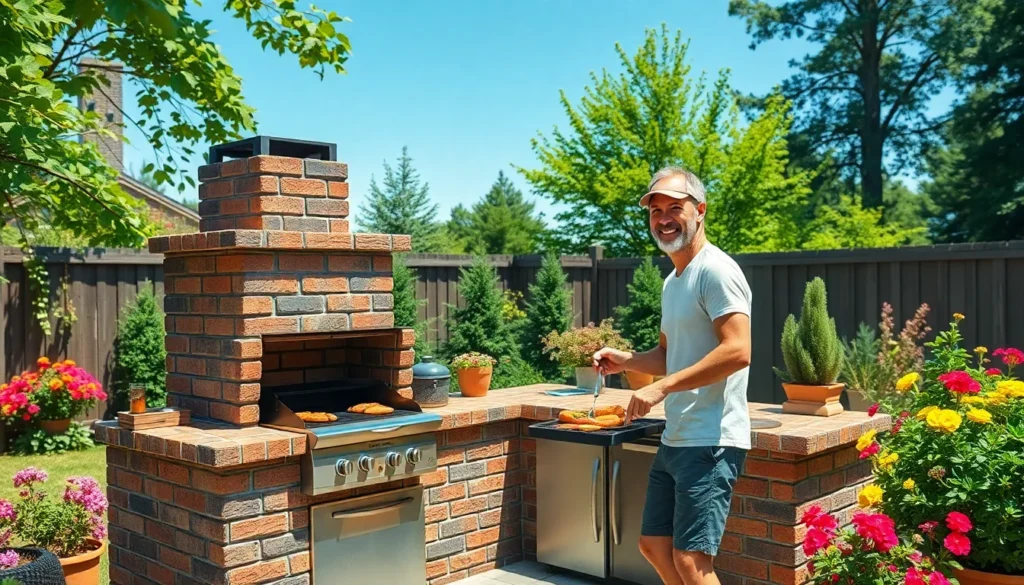Transform your backyard into the ultimate outdoor entertaining space with a stunning brick BBQ that’ll become the centerpiece of every gathering. We’ve compiled the most inspiring outdoor brick BBQ ideas that combine functionality with eye-catching design to help you create an outdoor cooking haven your family and friends will love.
Building a brick BBQ isn’t just about grilling – it’s about crafting an experience that brings people together. From rustic farmhouse designs to sleek modern installations these permanent outdoor cooking stations offer durability that’ll last for decades while adding important value to your property.
Whether you’re working with a compact patio or sprawling backyard we’ll show you creative brick BBQ designs that fit any space and budget. Get ready to discover innovative layouts built-in storage answers and design elements that’ll make your outdoor kitchen the envy of the neighborhood.
Traditional Brick BBQ Pit Designs for Classic Outdoor Cooking
Traditional brick BBQ pits embody the timeless art of outdoor cooking with time-tested designs that have served generations of grill masters. We’ll explore foundational construction methods that create durable cooking systems perfect for your backyard gatherings.
Basic Rectangular Fire Box Construction
Rectangular fire boxes form the heart of classic brick BBQ pit designs, offering maximum cooking space and heat distribution efficiency. We recommend constructing these boxes with standard fire bricks measuring 9 inches by 4.5 inches by 2.5 inches for optimal heat retention. Most traditional designs feature interior dimensions of 36 inches wide by 24 inches deep by 18 inches high, providing ample space for large cuts of meat and multiple cooking zones.
Building your fire box requires a solid concrete foundation extending 6 inches beyond the brick perimeter on all sides. Standard construction uses fire-resistant mortar joints measuring 0.25 inches thick between each brick course. Interior walls should incorporate air gaps or insulation chambers to prevent exterior surfaces from becoming dangerously hot during extended cooking sessions.
Drainage becomes crucial in rectangular fire box designs, so we suggest incorporating weep holes every 24 inches along the bottom course. These small openings prevent water accumulation while maintaining structural integrity throughout seasonal weather changes.
Adjustable Grill Grate Systems
Adjustable grill grates transform basic brick pits into versatile cooking platforms that accommodate different heat requirements and food types. We design these systems using stainless steel support brackets embedded directly into the brick mortar joints at multiple heights. Standard configurations include grate positions at 6 inches, 9 inches, and 12 inches above the fire box floor.
Heavy-duty grates measuring 0.25 inches thick provide superior heat retention compared to thinner alternatives. Custom-sized grates typically cost between $75 and $150 depending on dimensions and material quality. Removable grate designs allow for easy cleaning and maintenance while providing flexibility for different cooking styles.
Notched brick construction creates secure resting points for grate supports without requiring additional hardware. We position these notches at consistent intervals to ensure stable grate placement and prevent warping under high temperatures.
Built-In Chimney and Smoke Management
Built-in chimneys regulate airflow and smoke direction in traditional brick BBQ pits, creating optimal cooking conditions while keeping smoke away from dining areas. We construct these chimneys using standard 8-inch by 8-inch flue tiles stacked vertically and secured with high-temperature mortar. Proper chimney height should measure 24 to 36 inches above the highest point of your fire box for adequate draft.
Damper systems within the chimney allow precise airflow control during different cooking phases. Adjustable dampers cost approximately $40 to $80 and install easily within the flue system. Opening the damper increases oxygen flow for high-heat searing, while closing it partially maintains low temperatures for slow smoking.
Strategic air intake vents positioned near the fire box base work along with the chimney to create proper airflow circulation. These vents should measure 3 inches by 6 inches and include adjustable covers for temperature control. Positioning intake vents on the windward side of your BBQ pit ensures consistent airflow regardless of weather conditions.
Modern Brick BBQ Island Configurations for Entertaining Spaces
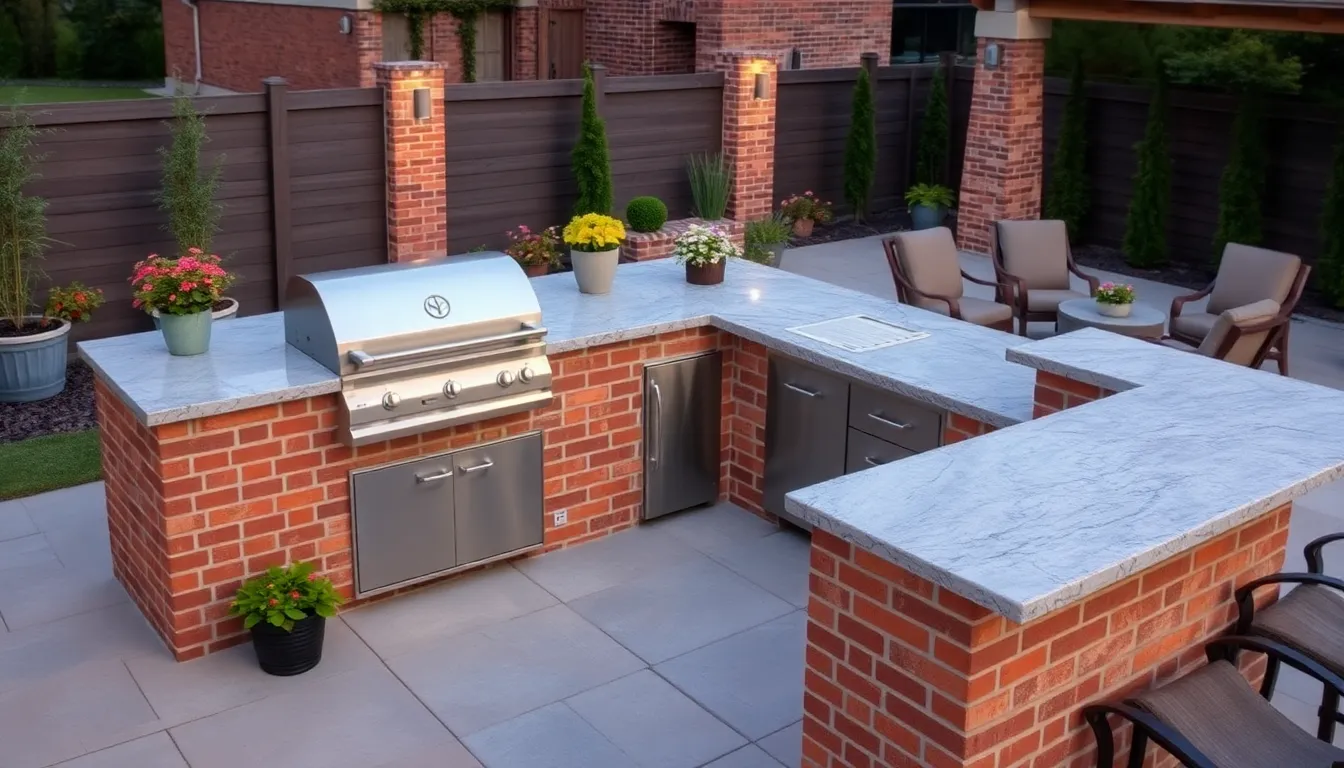
Today’s outdoor brick BBQ islands serve as multifunctional cooking centers that seamlessly blend social interaction with culinary excellence. These contemporary designs incorporate durable materials like concrete frames, stainless steel grills, and natural stone countertops to create weather-resistant entertaining hubs.
L-Shaped Counter Integration
L-shaped BBQ islands maximize your usable counter space while creating natural conversation zones around the cooking area. This configuration efficiently utilizes corner spaces in your backyard, providing ample room for food preparation, serving platters, and guest interaction without crowding the grilling zone.
Smart placement of these islands allows them to blend seamlessly with existing patio or deck sections, effectively extending your indoor kitchen space into the outdoor living area. The extended counter surface creates multiple work stations, enabling you to prep ingredients on one side while keeping finished dishes warm on the other.
Corner positioning of L-shaped designs also creates natural traffic flow patterns, preventing guests from clustering directly around the grill while maintaining easy access for the cook. This layout works particularly well in smaller backyards where space optimization is crucial for functionality.
Storage Compartment Planning
Built-in storage compartments under your brick countertop provide convenient access to grilling tools, utensils, and cooking supplies while protecting them from weather exposure. We recommend incorporating weather-resistant cabinetry or stainless steel drawers that withstand outdoor conditions and require minimal maintenance.
Strategic storage placement keeps frequently used items within arm’s reach of the cooking surface, reducing unnecessary movement during meal preparation. Consider dedicating exact compartments for different purposes: one for grilling tools, another for seasonings and marinades, and a third for serving accessories.
Accessibility becomes paramount when planning storage answers, as you’ll need quick access to items while actively cooking. Design compartments with easy-open mechanisms and sufficient depth to accommodate larger items like grill covers and charcoal bags.
Outdoor Kitchen Connectivity
Modern brick BBQ islands integrate seamlessly with broader outdoor kitchen systems, connecting grills, sinks, refrigerators, and seating areas into fully functional cooking environments. This connectivity allows you to create complete meal preparation zones that rival indoor kitchens in both capability and convenience.
Material coordination across all outdoor kitchen elements ensures visual harmony throughout your entertaining space. Matching stone veneer, granite countertops, and complementary furniture create cohesive designs that feel intentional rather than assembled piecemeal.
Multi-grill setups combining charcoal and gas options provide cooking versatility within a single island configuration, accommodating different cooking styles and fuel preferences. This dual-fuel approach lets you achieve smoky charcoal flavors when desired while maintaining the convenience of gas grilling for quick weeknight meals.
Utility connections for water, gas, and electricity should be planned during the initial design phase to avoid costly modifications later. Proper infrastructure planning enables seamless integration of additional appliances and features as your outdoor kitchen evolves.
Compact Brick BBQ Solutions for Small Patios and Yards
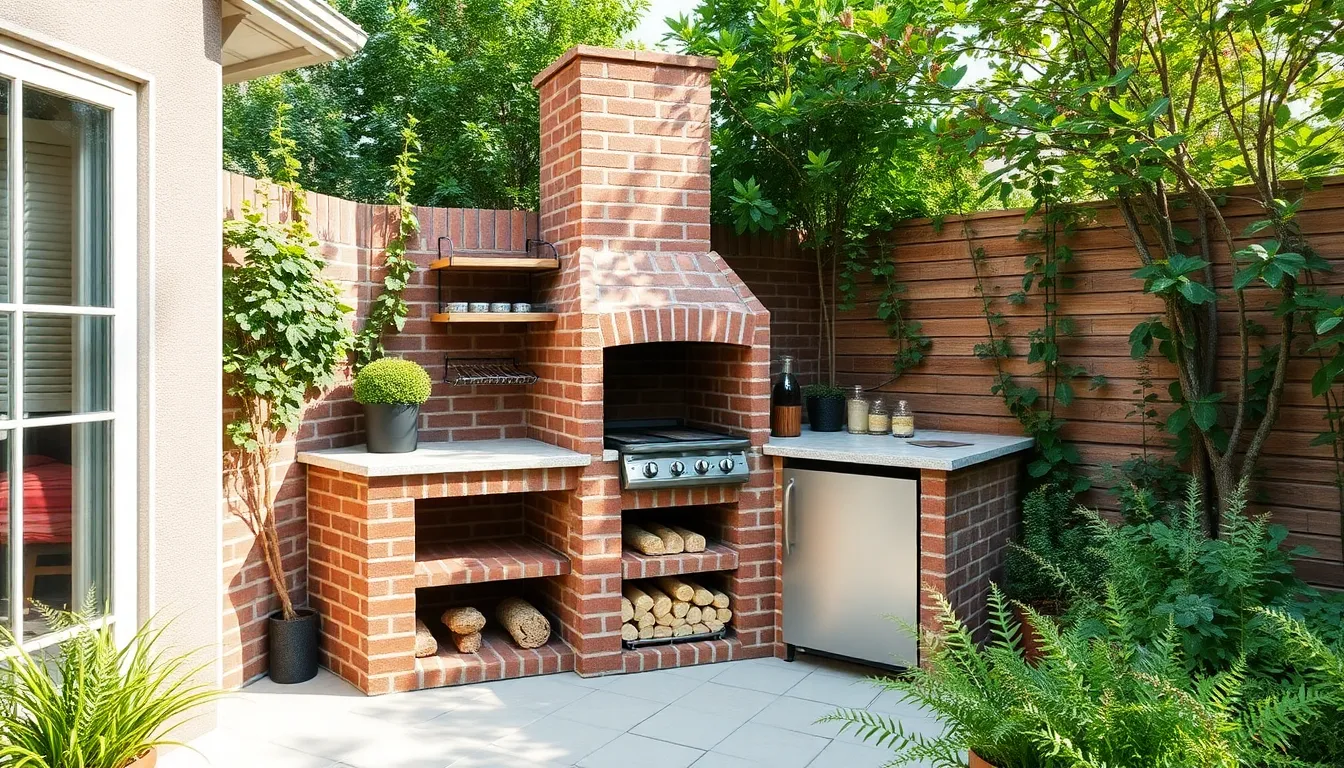
Small outdoor spaces don’t have to limit your BBQ dreams. We’ve discovered innovative compact brick answers that maximize functionality while fitting perfectly into limited areas.
Corner-Mounted Designs
Corner mounted brick BBQs transform underutilized patio corners into efficient cooking zones. We position these designs strategically to free up main patio areas for seating and movement while creating focused culinary spaces.
Wind protection becomes a natural benefit when we build BBQs in corners, as brick barriers shield the cooking area from breezes. Bar counters extending along adjacent walls can integrate seamlessly with corner units, creating cozy outdoor cookspaces that feel both intimate and functional.
Space efficiency reaches new levels when we use corners that typically remain empty. These designs allow us to maintain open flow in the central patio area while establishing a dedicated cooking zone that doesn’t interfere with foot traffic or furniture placement.
Vertical Space Optimization
Vertical construction maximizes cooking capacity when horizontal space is at a premium. We build vertically stacked barbecue units that include chimney components for superior heat management and smoke ventilation.
Chimney integration improves draft and smoke flow while adding architectural interest to backyard spaces. These vertical brick structures create visual height that draws the eye upward, making small patios appear larger than their actual dimensions.
Storage answers multiply when we add shelves and hooks along brick sides for tools, seasonings, and accessories. This vertical storage approach keeps essentials within arm’s reach while maintaining clean sight lines across the patio surface.
Portable Brick BBQ Options
Modular brick BBQs offer flexibility without sacrificing the traditional brick aesthetic. We design these units as smaller structures placed on wheeled bases or lightweight standalone systems that can be repositioned seasonally.
Material combinations blend brick with metal grills or frames, allowing movement while preserving durability and heat resistance. These semi portable answers work particularly well for renters or homeowners who prefer flexible outdoor arrangements.
Repositioning capability lets us adapt BBQ placement based on weather conditions, entertaining needs, or industry changes. Even though their moveable nature, these units maintain the classic brick appearance and heat retention properties that make brick BBQs so appealing.
Multi-Level Brick BBQ Structures for Versatile Cooking Methods
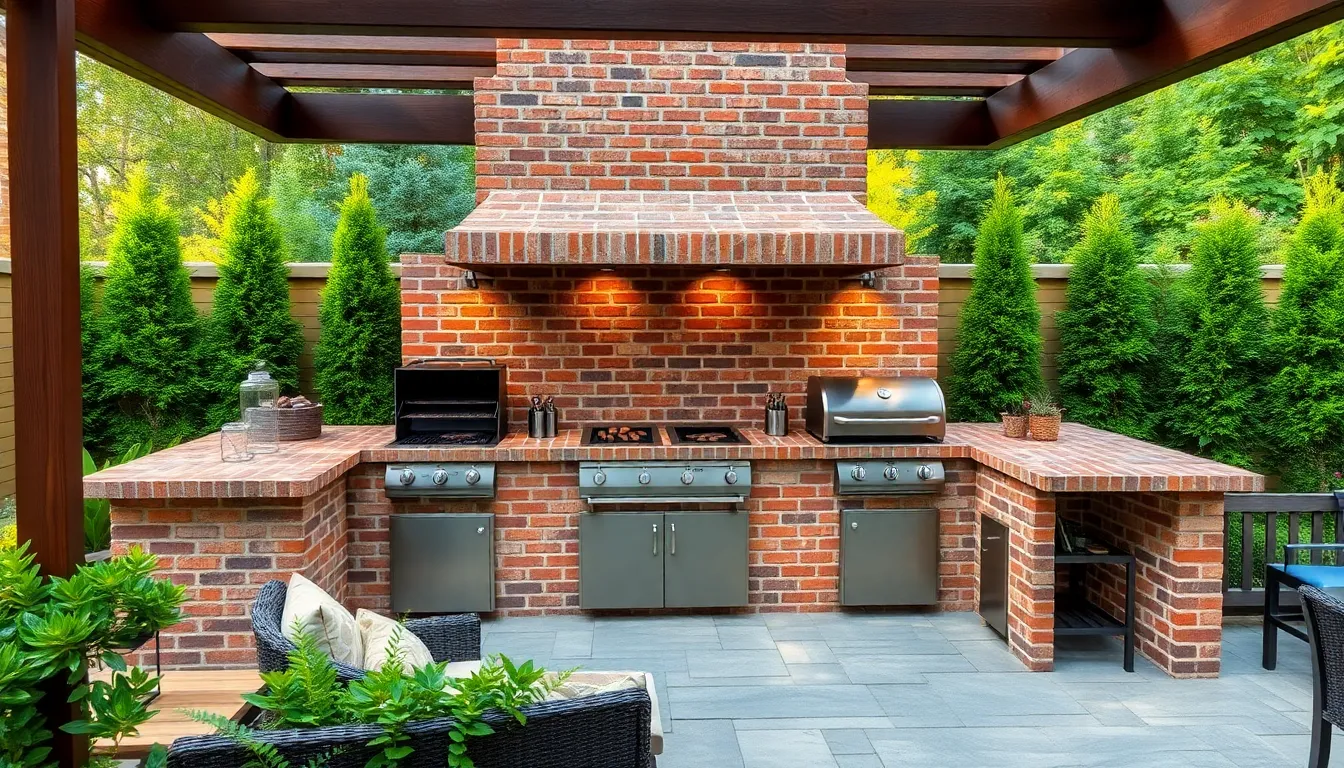
Multi-level brick BBQ structures revolutionize outdoor cooking by offering different zones for simultaneous cooking methods. We’ll explore how these innovative designs maximize your grilling potential through strategic height variations and specialized cooking areas.
Dual-Height Cooking Surfaces
Dual-height grilling surfaces transform your brick BBQ into a sophisticated cooking station that manages multiple heat zones simultaneously. We position the higher surface for indirect cooking and warming foods while the lower surface delivers direct grilling heat for searing meats. This configuration lets you prepare various dishes at once without cross-contaminating flavors or temperatures.
Brick construction provides excellent heat retention and stability for these multi-level surfaces. The thermal mass of brick materials maintains consistent temperatures across both levels, creating an efficient cooking environment that professional chefs appreciate. You can grill steaks on the lower grate while keeping vegetables warm on the upper level, streamlining your entire cooking process.
Separate Smoking and Grilling Zones
Incorporating distinct zones for smoking and grilling within the same brick structure allows for specialized cooking processes that expand your culinary possibilities. We design dedicated smoking chambers or side pits alongside the main grilling area, enabling slow-cooking of meats with rich smoke flavor while simultaneous grilling happens in the primary zone.
This segmentation enhances control over cooking methods and dramatically increases your BBQ’s functionality. A properly designed smoking zone maintains lower temperatures between 225-250°F while the grilling zone operates at higher direct heat levels. The brick walls between zones prevent heat transfer and allow independent temperature management for each cooking method.
Integrated Prep Areas
Adding countertop or prep space adjacent to your grilling zones improves convenience and workflow during outdoor cooking sessions. We integrate brick or stone prep areas that accommodate food preparation, seasoning, and serving without requiring trips back indoors. These surfaces become essential workstations that keep everything within arm’s reach.
Combining prep areas with storage niches or shelves within the brick structure optimizes space and enhances your outdoor cooking experience. Built-in storage compartments can house grilling tools, seasonings, and serving platters while maintaining the clean aesthetic of your brick BBQ design. The integrated approach creates a seamless cooking environment that rivals indoor kitchen functionality.
Decorative Brick BBQ Designs That Enhance Landscape Aesthetics
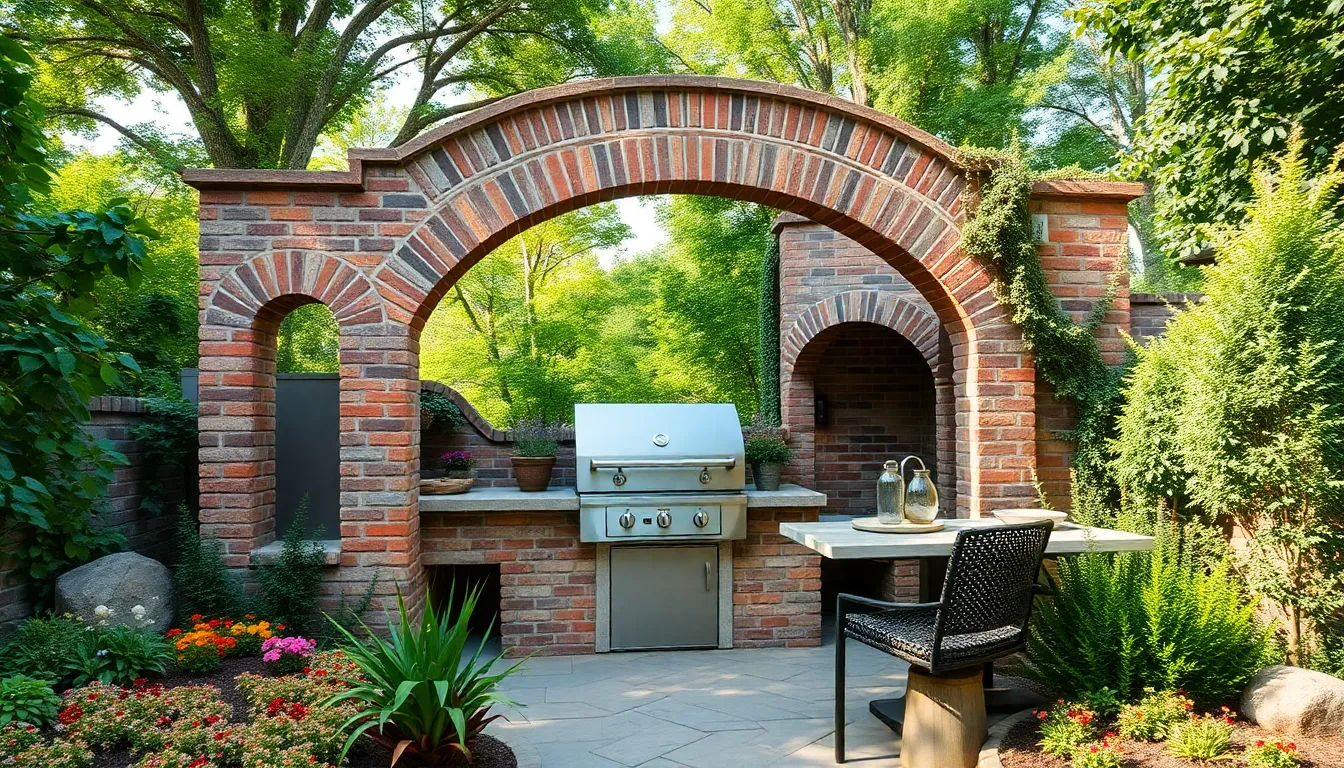
We’ve found that thoughtful architectural details and material choices can transform a simple brick BBQ into a stunning industry centerpiece. Strategic design elements help create focal points that enhance your backyard’s overall aesthetic appeal.
Arched Opening Styles
Arched openings add timeless elegance to outdoor brick BBQ structures while evoking traditional old-industry oven aesthetics. These curved architectural features frame your grilling area or firebox beautifully, creating visual interest that harmonizes with rounded elements like circular seating arrangements and curved countertops.
Beyond their visual appeal, arched openings provide practical benefits by improving airflow and heat circulation within the grill chamber. This enhanced ventilation creates better cooking conditions while maintaining the classic charm that makes brick BBQs so appealing.
We recommend considering arched openings when you want to blend functionality with sophisticated design elements. The curves soften the angular lines of traditional brick construction, creating a more inviting cooking environment.
Mixed Material Combinations
Stone combinations offer excellent durability and visual contrast when paired with brick BBQ structures. Slate, bluestone, or granite counters complement brick bases perfectly, providing heat-resistant surfaces that withstand outdoor elements while adding textural variety.
Wood elements bring warmth and softness to hardscape designs through integrated pergolas or shelving systems. These natural materials create visual balance against the sturdy brick foundation, making your outdoor cooking area feel more welcoming and less industrial.
Metal accents using stainless steel grills and hardware deliver a modern, industrial aesthetic that elevates traditional brick construction. This combination works particularly well for contemporary outdoor kitchens where sleek functionality meets classic durability.
Custom style flexibility emerges when you blend these materials thoughtfully, allowing designs to range from rustic charm to sophisticated contemporary appeal.
Garden Integration Techniques
Positioning strategies matter significantly when integrating brick BBQs into your industry design. Placing your BBQ structure near existing garden beds or green areas creates natural transitions between built and natural elements, making the cooking area feel like an organic part of your outdoor space.
Visual continuity develops when you use brick materials that match your garden walls or existing pathways. This coordination creates a cohesive look that ties your outdoor cooking area into the broader industry design.
Built-in planters and herb gardens incorporated directly into BBQ structures add both greenery and practical cooking benefits. These living elements soften the hardscape while providing fresh ingredients right where you need them.
Wind barriers and seating walls constructed from matching brick materials frame your cooking space effectively while increasing comfort for guests. These functional elements create intimate cooking zones that feel protected and well-defined within your larger garden setting.
Pizza Oven and BBQ Combination Brick Structures
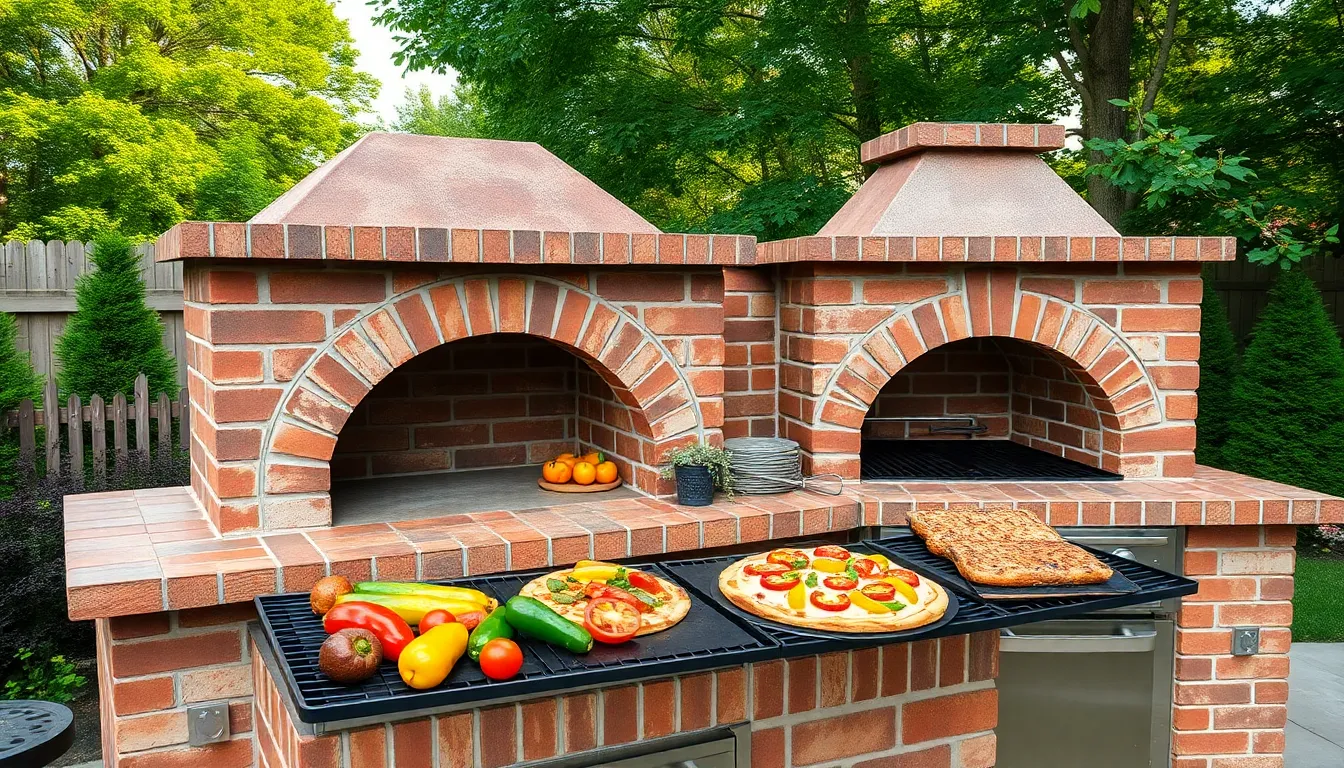
Combining pizza ovens with BBQ grills in unified brick structures maximizes outdoor cooking versatility while creating stunning focal points. These integrated designs feature separate cooking chambers that allow simultaneous operation of both cooking methods.
Dual-Purpose Dome Construction
Building dual-purpose domes transforms your outdoor cooking capabilities by creating chambers that serve multiple functions. Pizza oven domes constructed with heat-retentive firebricks naturally retain and spread heat evenly, making them perfect for both high-temperature pizza cooking and slower BBQ smoking processes.
Adjustable vents and dampers within dome structures regulate airflow and create distinct temperature zones for different cooking styles. We’ve found that dome shapes inherently provide efficient heat circulation, enabling you to switch between rapid pizza cooking at 700-900°F and gentle smoking at lower temperatures.
Temperature control becomes more precise when domes incorporate movable grills or multi-level cooking grates that use varying heat intensities. These flexible cooking surfaces let you position food at optimal distances from heat sources based on your cooking requirements.
Shared Chimney Systems
Designing shared chimney systems reduces construction complexity while efficiently managing smoke from both cooking areas. Common flue designs collect smoke from dome ovens and open BBQ fireboxes through a single ventilation system, cutting material costs and simplifying installation.
Proper chimney height and strategic placement ensure effective smoke removal, preventing buildup around cooking zones that could affect food quality. We recommend positioning shared chimneys to draw smoke naturally upward from both chambers without creating draft interference.
Construction benefits multiply when shared systems incorporate weather-resistant materials and proper insulation around flue connections. These unified ventilation approaches create cleaner cooking environments while maintaining the structural integrity of combined brick BBQ systems.
Temperature Zone Management
Managing distinct temperature zones within combination structures requires strategic design and quality materials. Pizza ovens typically demand consistent high heat between 700-900°F for quick cooking, while BBQ sections operate effectively at moderate temperatures ranging from 225-350°F.
Separate fireboxes provide independent heat control for each cooking chamber, allowing simultaneous preparation of different foods. Insulating materials like firebrick and refractory mortar retain and direct heat precisely where needed, creating stable temperature environments.
Adjustable vent systems control airflow to each zone, giving you precise temperature management capabilities throughout your cooking sessions. We’ve observed that multi-level grate systems within fire chambers optimize heat distribution, letting you position foods according to their exact temperature requirements.
| Temperature Zone | Cooking Method | Temperature Range | Typical Foods |
|---|---|---|---|
| Pizza Oven Dome | High-Heat Cooking | 700-900°F | Pizza, Bread, Roasted Vegetables |
| BBQ Grill Section | Moderate Grilling | 300-450°F | Burgers, Steaks, Chicken |
| Smoking Chamber | Low-Slow Cooking | 225-275°F | Brisket, Ribs, Pulled Pork |
Budget-Friendly DIY Brick BBQ Projects for Weekend Warriors

Weekend DIY enthusiasts can build impressive brick BBQs without very costly or requiring professional masonry skills. Simple designs using basic materials like bricks or cinder blocks offer cost-effective alternatives to expensive commercial grills.
Reclaimed Brick Sourcing
Salvage yards provide excellent sources for character-rich reclaimed bricks at significantly lower costs than new materials. Demolition sites often offer bulk quantities of vintage bricks that add unique texture and weathered charm to your BBQ design. Restoration projects frequently discard quality bricks that we can repurpose for sustainable building practices.
Variability in reclaimed materials creates distinctive visual appeal through mixed colors, textures, and sizes that new bricks can’t replicate. Construction companies sometimes allow homeowners to collect bricks from job sites, providing free materials for DIY projects. Estate sales and classified ads occasionally feature reclaimed building materials from home renovations.
Quality assessment becomes crucial when selecting reclaimed bricks to ensure they’ll withstand high heat and weather exposure. Fire bricks from old chimneys or kilns offer superior heat resistance for cooking surfaces. Local architectural salvage stores often stock sorted, graded reclaimed bricks ready for construction projects.
Simple Mortar-Free Designs
Dry stacking methods eliminate the need for specialized masonry skills while creating stable, functional BBQ structures through careful brick placement. Weight distribution and interlocking arrangements provide structural integrity without permanent mortar bonds. Gravity holds these designs together, making them ideal for renters or those wanting temporary installations.
Cinder block construction offers the simplest mortar-free approach for creating basic grill platforms with built-in ventilation gaps. Block arrangements can accommodate standard grill grates while providing storage space for charcoal and cooking tools. Heavier blocks create more stable foundations for larger cooking surfaces.
Ventilation gaps naturally occur in dry-stacked designs, improving airflow for better combustion and easier ash removal. Disassembly remains possible for seasonal storage or relocation to different areas of your property. Adjustments and modifications become straightforward without demolishing mortar joints.
Basic Tool Requirements
Essential hand tools keep equipment costs minimal for most DIY brick BBQ projects, particularly mortar-free designs. A quality level ensures straight, stable construction that prevents wobbling or uneven cooking surfaces. Measuring tape helps maintain consistent spacing and proper proportions throughout the build.
Safety equipment protects builders during construction activities including work gloves and safety glasses for handling rough materials. Rubber mallets allow gentle adjustments to brick placement without cracking or chipping the materials. Brick chisels enable custom fitting when exact shapes or sizes are needed.
Power tools expand capabilities for more complex projects such as angle grinders for cutting bricks to custom dimensions. Trowels become necessary only when using mortar for permanent installations. Basic wheelbarrows or hand trucks help transport heavy materials efficiently around your work area.
Professional Brick BBQ Installations for Luxury Outdoor Living

Professional brick BBQ installations elevate outdoor cooking from basic grilling to sophisticated culinary experiences. These premium constructions integrate seamlessly with luxury outdoor living spaces while delivering exceptional functionality and lasting value.
Custom Masonry Work
Custom masonry transforms ordinary outdoor spaces into extraordinary cooking destinations through skilled craftsmanship and premium materials. We recommend working with experienced masons who understand the unique requirements of outdoor cooking structures and can create customized answers for your exact space and preferences.
High-quality bricks form the foundation of these installations, selected for their durability and aesthetic appeal. Professional masons incorporate unique shapes and sizes to match your outdoor design vision while ensuring structural integrity. Built-in storage compartments become natural extensions of the masonry work, providing convenient access to grilling tools and supplies without compromising the overall design.
Preparation areas integrate seamlessly into the brick structure, creating efficient workflows for outdoor cooking. These custom features maximize functionality while maintaining the elegant appearance that distinguishes professional installations from DIY projects.
Built-In Utility Connections
Built-in utility connections distinguish luxury brick BBQs from standard outdoor grills by providing comprehensive cooking capabilities. Gas lines enable versatile cooking options, supporting both traditional charcoal sections and modern gas burners within the same structure. Water connections help easy cleanup and expand cooking possibilities with features like steam injection systems.
Electrical connections power essential elements including lighting systems for evening entertaining and ventilation fans for improved smoke management. Planning these utility installations during the construction phase ensures clean, professional appearances without exposed wiring or temporary connections.
Professional installers coordinate with utility companies to ensure proper permits and safe installations that meet local building codes. This comprehensive approach creates outdoor kitchens that rival indoor cooking facilities in both functionality and convenience.
Weather Protection Features
Weather protection features ensure year-round usability and long-term durability of professional brick BBQ installations. Chimney caps provide essential protection from rain while preventing wind downdrafts that can affect cooking performance. These architectural details combine functionality with aesthetic appeal, often becoming focal points of the overall design.
Brick wind barriers create sheltered cooking areas that improve comfort and control smoke direction during outdoor cooking sessions. These barriers integrate naturally with the overall masonry work while providing practical benefits for entertaining guests in various weather conditions.
Professional installations incorporate drainage systems and weatherproofing materials that protect utility connections and structural elements from moisture damage. Covered preparation areas extend the usable cooking season while protecting food preparation surfaces from the elements.
Maintenance and Care Tips for Long-Lasting Brick BBQ Performance
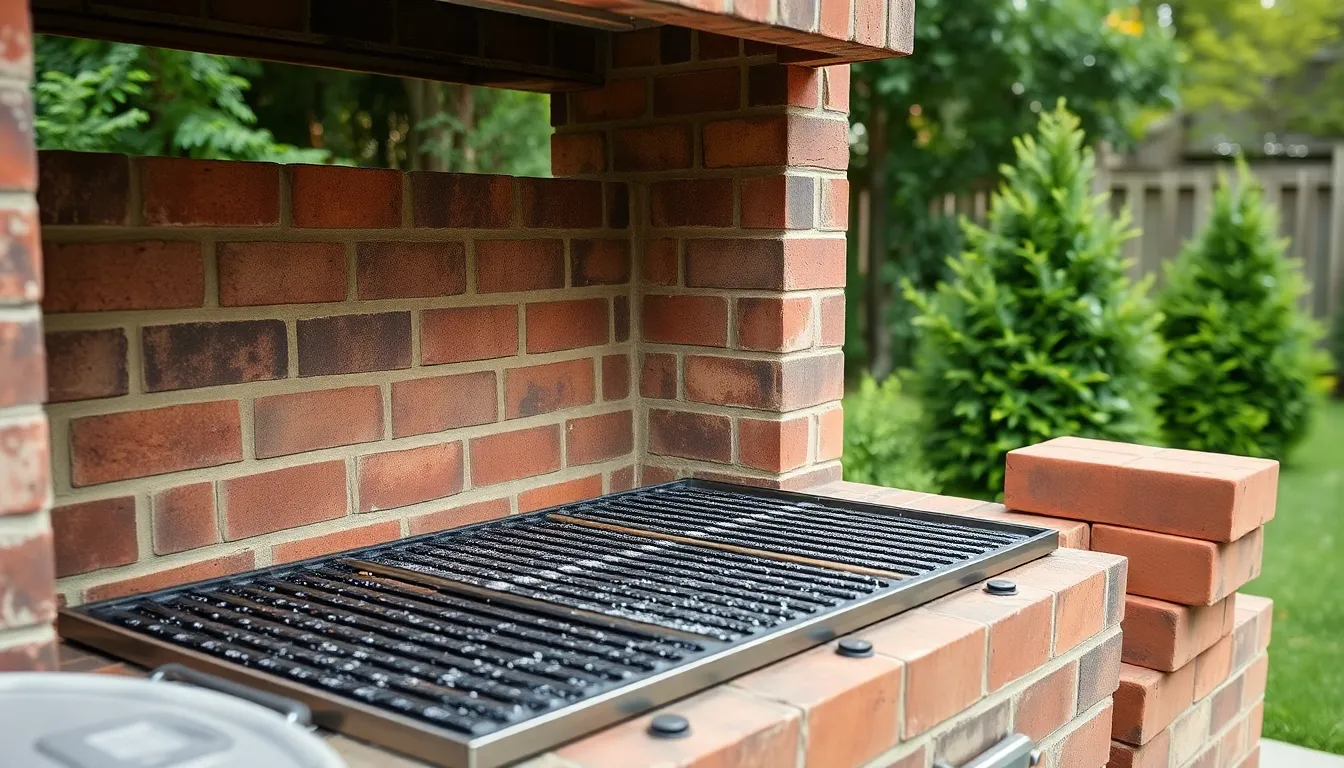
Regular maintenance ensures your outdoor brick BBQ remains a reliable centerpiece for years of exceptional grilling experiences. We’ll guide you through essential seasonal cleaning procedures, mortar joint inspection, and fire brick replacement to maximize your investment’s longevity and performance.
Seasonal Cleaning Procedures
Spring preparation sets the foundation for successful grilling seasons ahead. We recommend thoroughly cleaning grill grates and inspecting all components including grease traps and burners before your first cookout. Wire brushes combined with vinegar and baking soda answers effectively remove accumulated grease and residue from winter storage.
Peak grilling season demands frequent cleaning to maintain optimal burner performance. Daily cleaning prevents buildup that can affect heat distribution and create unpleasant flavors in your food. Quick post cooking maintenance keeps your BBQ functioning at its best throughout busy summer months.
Fall deep cleaning removes all cooking residue and empties accumulated ashes from your fire box. This thorough cleaning prevents corrosion during dormant months and prepares your BBQ for winter protection. Scraping away grease deposits now saves important effort when spring arrives.
Winter weatherproofing protects your brick BBQ from harsh weather conditions that cause structural damage. We suggest cleaning and drying all surfaces thoroughly before applying protective covers to prevent water infiltration. Applying sealant to brick surfaces creates an additional moisture barrier that prevents cracking and deterioration during freeze thaw cycles.
Mortar Joint Inspection
Checking mortar joints between bricks reveals early signs of structural weakness before major repairs become necessary. We examine these joints regularly for cracks or deterioration that compromise your BBQ’s integrity. Small cracks often indicate normal settling but larger gaps require immediate attention.
Repointing damaged mortar prevents moisture intrusion that causes bricks to loosen or crack under thermal stress. This repair process involves removing deteriorated mortar and replacing it with fresh material that matches your original construction. Prompt attention to joint issues saves expensive reconstruction costs later.
Structural weakening occurs when damaged mortar joints allow water penetration during winter months. Freeze thaw cycles expand trapped moisture and create additional damage that spreads throughout your BBQ structure. Regular inspection catches these problems early when simple repairs suffice.
Fire Brick Replacement
Inspecting fire bricks reveals heat damage that compromises your BBQ’s cooking efficiency and safety performance. These inner heat resistant bricks endure extreme temperatures that cause cracking and deterioration over time. We check for visible damage during routine cleaning to identify replacement needs.
Replacing cracked or broken fire bricks maintains proper insulation and heat containment essential for safe cooking. Damaged fire bricks allow excessive heat transfer to outer structural bricks and reduce cooking efficiency. Swift replacement prevents further damage to surrounding masonry work.
Using appropriate refractory mortar ensures fire brick repairs withstand high temperature cooking conditions. Standard mortar fails under extreme heat and compromises your repair work’s effectiveness. We select specialized high temperature mortars designed specifically for fire brick applications to guarantee lasting repairs.
Conclusion
Building an outdoor brick BBQ transforms your backyard into the ultimate entertaining destination. Whether you’re drawn to traditional pit designs or modern island configurations we’ve shown you options that fit every space and budget.
From compact corner units perfect for small patios to elaborate pizza oven combinations these versatile structures offer endless possibilities for outdoor cooking. The durability of brick construction means your investment will provide years of reliable service while adding important value to your property.
Remember that proper maintenance keeps your brick BBQ performing at its best. With regular cleaning and timely repairs your outdoor cooking centerpiece will continue delivering exceptional results for countless gatherings with family and friends.
Frequently Asked Questions
What are the main benefits of building a brick BBQ in my backyard?
A brick BBQ offers exceptional durability, weather resistance, and heat retention compared to portable grills. It significantly increases property value while creating a permanent entertaining focal point. Brick BBQs provide superior cooking performance, require minimal maintenance, and can be customized to match your home’s architectural style and outdoor space needs.
How much space do I need for a brick BBQ installation?
Space requirements vary by design. Compact corner-mounted units work in spaces as small as 4×4 feet, while full BBQ islands need 8×12 feet minimum. Consider clearance requirements of 3 feet from structures and property lines. Even small patios can accommodate vertical or portable brick BBQ designs without compromising functionality.
Can I build a brick BBQ myself or do I need professional installation?
Simple DIY brick BBQs are achievable for weekend warriors using basic tools and mortar-free construction methods. However, complex designs with utility connections, built-in storage, or combination pizza ovens typically require professional masonry skills. Consider your experience level, local building codes, and desired features when deciding between DIY and professional installation.
What’s the difference between traditional brick BBQ pits and modern BBQ islands?
Traditional brick BBQ pits feature simple rectangular fireboxes focused purely on cooking functionality. Modern BBQ islands incorporate multiple cooking surfaces, built-in storage, counter space, and integrated appliances like sinks or refrigerators. Islands offer more versatility and convenience but require larger spaces and higher budgets than traditional pits.
How do I maintain my brick BBQ for optimal performance?
Perform seasonal cleaning by scrubbing grates, removing ash buildup, and inspecting fire bricks for cracks. Check mortar joints annually for weathering or damage. Replace worn fire bricks promptly to maintain cooking efficiency. Clean the chimney regularly to ensure proper ventilation. Store covers during harsh weather to protect surfaces and extend lifespan.
Can I combine a pizza oven with my brick BBQ?
Yes, dual-purpose brick structures can house both pizza ovens and BBQ grills. These combination units feature shared chimney systems and distinct temperature zones. The dome construction allows high-temperature pizza cooking while maintaining separate areas for slower BBQ smoking. This design maximizes cooking versatility within a single outdoor structure.
What materials do I need for a budget-friendly DIY brick BBQ?
Source reclaimed bricks from salvage yards for character and cost savings. Use standard fire bricks for the cooking chamber, basic mortar, and metal grates. Essential tools include a trowel, level, measuring tape, and safety equipment. Cinder blocks offer an even more affordable alternative for the base structure in simple designs.
How do decorative brick BBQ designs enhance my landscape?
Decorative elements like arched openings, mixed materials, and integrated planters create visual appeal while maintaining functionality. Thoughtful positioning creates natural transitions between built structures and existing landscaping. Built-in herb gardens provide convenient cooking ingredients while adding greenery. These features transform utilitarian BBQs into attractive landscape focal points.

